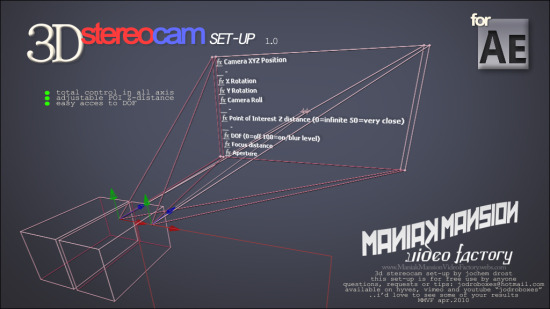Connect with Trapcode
Search
News Archive

Copyright © 2001-2016, Trapcode AB. All rights reserved. Trapcode is a registered trademark of Trapcode AB.

 Thursday, April 29, 2010 at 9:00PM
Thursday, April 29, 2010 at 9:00PM

Reader Comments (9)
Thanks for sharing your technique!
This is very cool, I love the test video with Particular v2, that smoke trail really jumps out of the screen when I wear my red/green glasses.
I think a video tutorial would be helpful.
Peder Norrby / Trapcode
thank you, i want to make a tutorial but i need a good screen capture program.
i have camstudio 2 but its not very good, what program do you use??
How does this process of 3D differ from the 3D process we have seen in 'Avatar' and 'Clash of the Titans'?
I have done some research and it seems that 'Real D 3D', the kind that we see in theaters projects two images, left and right perspectives alternatively. While our left eye is shown the left perspective the right eye is sees nothing (because of the polarizing glasses), and visa versa, this full cycle (L-R) occurs 30 times a second (to best of my knowledge). As a result, our brain then interprets the two POV's as a single image an we are left with the sensation of having just witnessed something that existed (in our brains) as being 3D.
However the key to all this is selectively showing each eye the right perspective, which explains why we use Cyan and Red. Ideally we should not have to reply on just two colours to achieve the 3D effect, but instead we should polarize the light. The problem that exists with this process is that our screens are not capable of doing that. I have tried to create a hybrid which switches between the L and R images quick enough in addition to using a selective coloring.
In the comp below it begins with the normal overlay (for comparison). Then in the second part I have the two perspectives alternating, it is a 50 fps comp, 25 left blue, 25 right red. Keep in mind that I do not own a pair of Anaglyph glasses so I have no idea how well this works, if it even works at all.
Maybe you could watch it for me? 6mb in total, just right click to download.
stereocamanaglyph_render_out_1.mov
There is actually a really nice simple explanation of Real 3D processing over here (http://bit.ly/9lW7bj) which is sort of what I reference while doing this.
This might all be nonsense but it's fun experimenting!
Thanks for the .ae project file too
There's a great overview of all the different 3D projection and viewing methods at this post here: http://gizmodo.com/5472332/how-3d-works-a-simple-picture-guide
Most theaters use the Polarized glasses.
@youssef thats an interesting thought and it kinda works, . the only problem is there is a lot of flickering. i dont think 50 fps is enough, 120fps might do the job much better but the R/B artifacts will still show up. so there is not much use in this technique for anaglyph video's. there is a lot of development going on in 3D, in the future its normal to have a 3d tv. check this out: http://www.nvidia.com/object/3D_Vision_Main.html
this works on a 120hz screen and shutter glasses. thanks for the comment
Hi,
I just wanted to correct something: Real D is the circular polarisation, both images are projected at the same time and each eye sees only the image it has to see depending on its polarization (so there is no flickering). In the other hand, the devices used at home use active shutter glasses that bloc one eye at a time and that's why at least 120Hz is recommended to see "comfortable" stereoscopy.
How does this process of 3D differ from the 3D process we have seen in 'Avatar' and 'Clash of the Titans'?
Hopefully they had a better workflow =)
In essence there is no difference, two cameras are used to create images for left and right eye.
personally hollywood already has 3d locked down so why bother the real question is how are we going to integrate holograms into cinema so that the scene is actually playing in 3d space and were not relying on tricking ones eye.
Good news everyone!
3D Stereocam 2 is almost done, just a few more days!
Stereocam 2 will update the 3D scene inside AE. So no more rendering to see what it looks like. And it supports TC plugins. Other anaglyph setups that render inside AE do not support 3D plugins because of the collapse transformation issue.
I also improved and added some controls. Life is short, you know.
i'll make a tutorial on how t all works. (1st tut, damn i'm nervous)
cheers and keep an eye out on this,
jochem